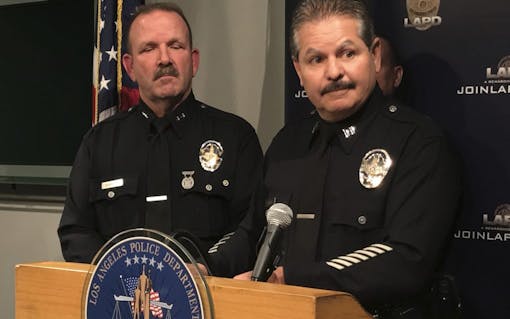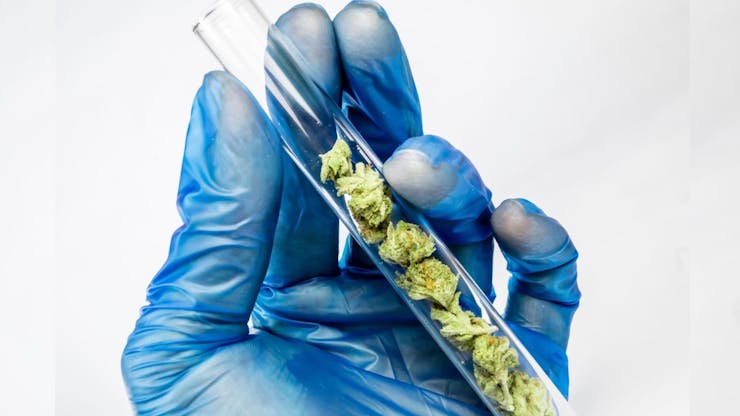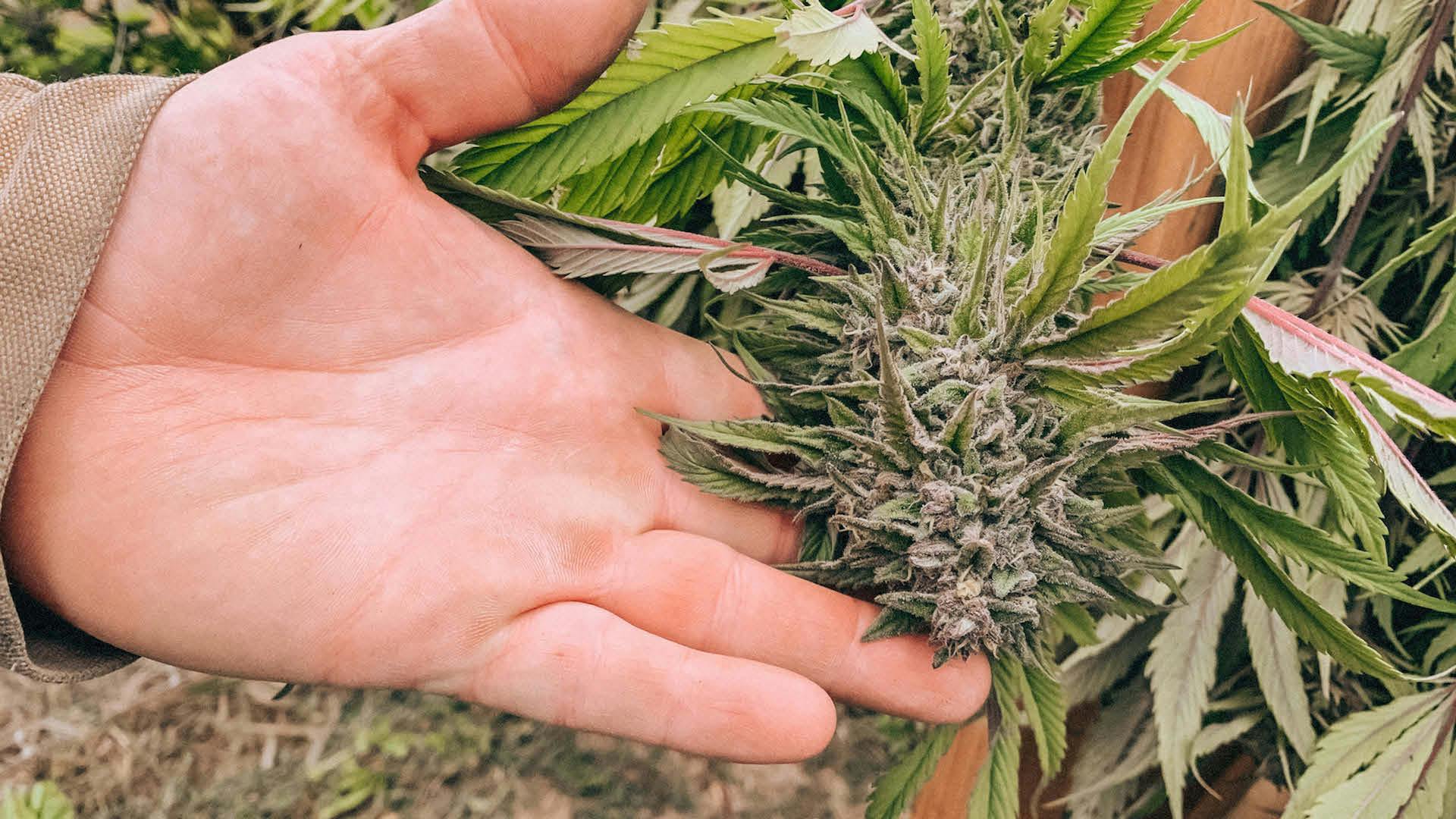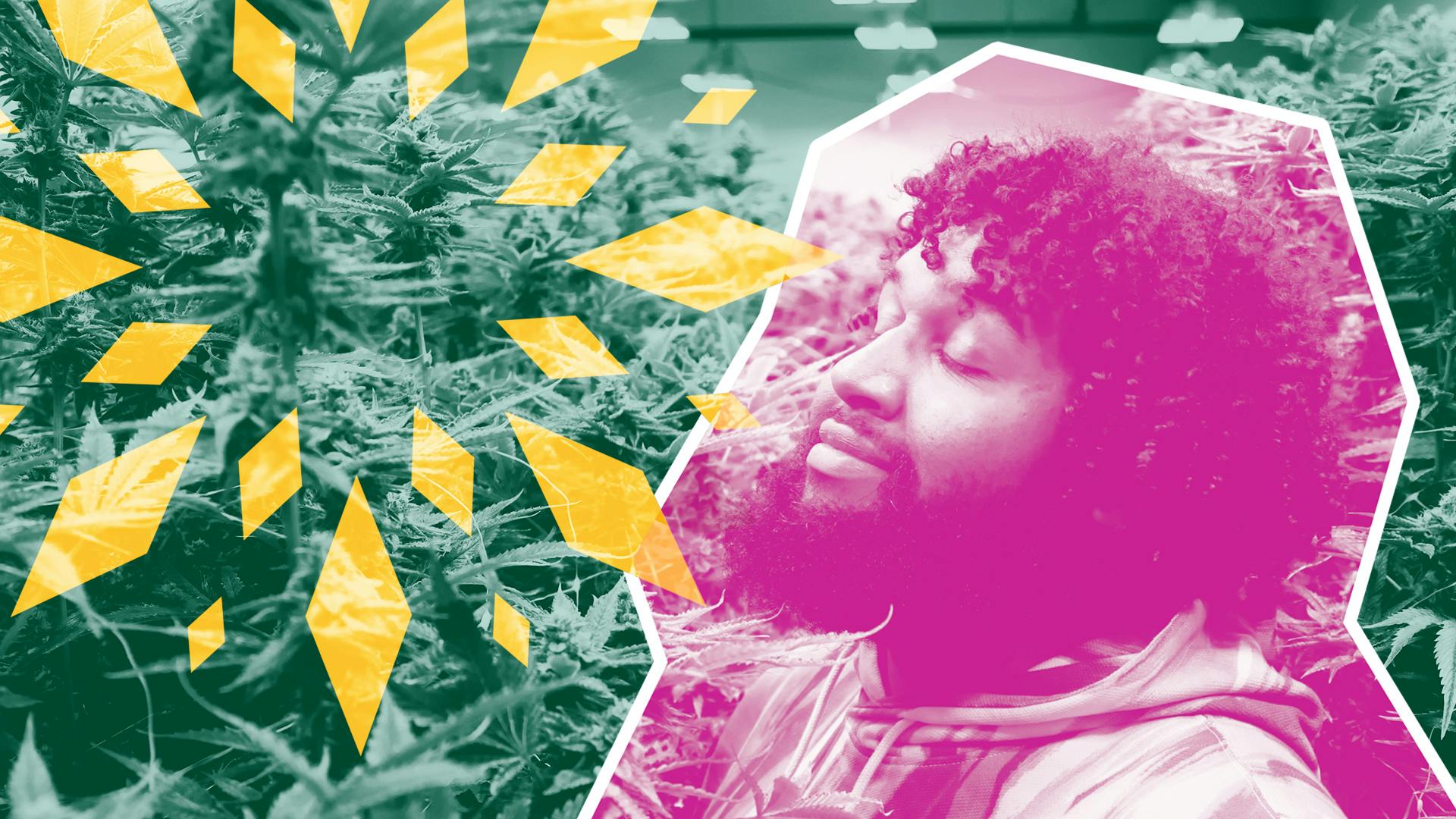Police and media keep spreading scary stories about ‘fentanyl-laced marijuana.’ But lab tests never back them up. Here’s what’s driving the disinformation—and how to stop it.
The past two years have seen an eruption of alarming headlines about “fentanyl-laced marijuana” causing overdoses and hospitalizations.
These claims now pop up about once a month. The alarm gets rung by police, then amplified by local and national media.
Here’s the truth: America does not have a fentanyl-laced weed problem.
When the message gets repeated, people start to believe that fentanyl-laced weed is a real threat to cannabis users.
But in reality: America’s fentanyl-laced weed problem doesn’t exist at all.
Over the past six months, Leafly has investigated and analyzed claims of fentanyl-laced cannabis from across the country. Many of our readers are medical marijuana patients or adult cannabis consumers. If they face a serious risk using any cannabis-related products, we intend to let them know about it.
What we can tell you is this: The “fentanyl-laced marijuana” scare is false. Over and over, state lab tests have disproven police claims of cannabis suspected of contamination.
The lie spreads from three sources: Faulty field drug testing kits, police departments incentivized to hype local fear, and reporters who fail to question, investigate, or follow up on police claims.
Meanwhile, simple economics reveal that adding fentanyl to even just a dime bag of weed is a huge money-loser for anyone who sells both drugs. We’ll break down the evidence below, along with expert analysis on what continues to fuel the fentanyl-laced weed myth.
This is what a drug panic looks like
To give you a sense of how these stories make their way into the public’s mind, consider the two most recent examples.
On the morning of May 27, 2022, a man near Park City, Utah, called police and said he had an adverse health reaction after smoking cannabis. “After testing the marijuana,” the Summit County Sheriff’s Department announced, “deputies believe it to be laced with the deadly drug Fentanyl.”
The deputies reported the field test results as settled fact. What they didn’t mention is that the drug testing kits police use in the field are notoriously unreliable—so unreliable that they’re not even admissible in court. A New York Times / Pro Publica investigation into America’s field drug tests concluded: “Widespread evidence shows that these tests routinely produce false positives.”
Nevertheless, that same day, the Summit County Sheriff’s office issued a press release and put out a public-alarm tweet.
PSA – Today #SummitCounty Deputies learned a resident experienced a reaction after smoking marijuana he purchased from a 25yo Silver Summit man. The marijuana also field tested positive for Fentanyl. Brooks Tyler Glisson has been arrested on drug possession & distribution. pic.twitter.com/Pzw3hM0Zli
— Sheriff Justin (@SummitCountySO) May 27, 2022
The claim was quickly amplified by news stations in Salt Lake City, Seattle, New York, Orlando, San Antonio, Miami, Tulsa, and Jacksonville. Nearly all of them ran the same story, a rewrite of the Summit County Sheriff’s press release published by the Cox Media Group National Desk.
If history is any guide, we should expect the Summit County Sheriff’s Department to quietly walk back that fentanyl-laced weed claim within the next few months—after thorough examination by a state crime lab disproves that initial field test.
The retraction probably won’t merit a press release or follow up tweet. And the Cox Media Group National Desk won’t write a follow-up story, but they will jump on the next fentanyl-laced weed headline like clockwork.
A few weeks after the Utah incident, a retired cop named Dale Lawrence spun a shocking story about fentanyl-laced marijuana for YouTube’s Law & Crime network:
“We’ve had a couple of deaths of young kids who were just smoking a joint. They’re not drug addicts, they’re not heroin addicts, they’re not coke addicts, they’re not even pill heads. They’re just a kid smoking a joint, laced with fentanyl. So that’s what you’re seeing now. And obviously we know where that’s coming from with the open borders. That’s the big thing that we’re seeing up here on the East Coast, is just a run of the mill, nice kid, smoking a joint dropping dead because it’s laced with fentanyl.”
Dale Lawrence, retired cop
This is pure myth making. Lawrence amps the hysteria by leaping from an unreliable drug field test to claiming that kids were actually dropping dead after hitting a single joint. Lawrence tosses in some racist xenophobia—“we know where that’s coming from with the open borders”—just for added flavor.
While he may be the crudest example of the dynamic at play, Dale Lawrence’s false message is getting picked up and spread nationwide. The misinformation cycle is damaging for two reasons.
First, it stokes fear for cannabis consumers living in prohibition states who have to buy from the illicit market, where no product testing or safety regulations exist.
Second, it affects the political conversation around legalization and drug reform. Though nearly all of these stories are untrue, their repetition has an effect that ripples up to the halls of power. A couple months ago, Florida Sen. Marco Rubio said that he’s against cannabis legalization because he believes that legalizing for adults entices more teens to try illicit weed, which he claimed is “laced with fentanyl.” Rubio’s false claims went unchallenged.
A timeline of false fentanyl claims

False claims of “fentanyl-laced weed” go back years. Leafly began documenting these unfounded reports back in 2016 and 2017. Like the fear of razor blades in Halloween candy bars, they’re perennially scary in theory, but never proven in fact.
Here are just a few examples of federal and state officials igniting fears about fentanyl-laced weed without evidence:
- July, 2018: An official from the National Institute on Drug Abuse (NIDA) said in a speech, “Fentanyl is being used to lace a wide variety of drugs, including marijuana.” When asked for proof, the office referred to a 2015 police report from Vancouver that had been disproven in 2016.
- June, 2019: The Associated Press reported that a sheriff in upstate New York walked back claims of fentanyl-laced weed after lab tests came back negative for fentanyl.
- November, 2021: Police in Vermont reported an overdose patient saved by Naloxone, and said the patient claimed “they had not used any opiates, and had only smoked marijuana.” Police later arrested three people, claiming field tests showed their weed was positive for fentanyl. They initially refused to release the lab results, but soon admitted the truth: that fentanyl-laced pot was never found.
- December, 2021: The Hampden County, Massachusetts, district attorney’s office spread a rumor that fentanyl-laced weed had landed two local high school students in the hospital. The rumor was later disproven.
- December 2021: Michigan’s state poison control center issued a statewide “public health alert” and claimed that officials there had turned up eight cases of fentanyl-laced marijuana since June 1. Officials reported eight suspected cases, but none were confirmed by actual lab tests.
- February, 2022: Health officials in Connecticut claimed to record 40 cases of opioid overdose due to fentanyl-laced marijuana, but only one test came back positive, and it was likely from cross-contamination, according to public health officials.
- May, 2022: Oneida County, New York, overdose prevention coordinator Lisa Worden told CBS-WKTV, “If you’re a person who uses street drugs, whether that’s K2, synthetic marijuana, whatever it is, you have to assume fentanyl is in it.” The same department made this claim back in 2019, with absolutely zero evidence.
In every instance above, state officials failed to find a single victim of fentanyl-laced weed, or a lab test that definitively confirmed its existence. Some departments have walked their statements back. But many authorities and news outlets continue to spread this reckless myth.
To be clear, the adulteration of some drugs with fentanyl is a real and deadly issue. A dealer told Leafly that the current supply of opioids on the street is so compromised by fentanyl that selling pure heroin is not economically sustainable.
Public access to drug testing is an important harm reduction service advocated by reputable orgs and countries that have reduced addiction rates. We encourage consumers of any substance to know what they’re taking before they take it.
Fentanyl-laced weed is a myth
In reality, Fentanyl traces have only been found in one cannabis sample on American soil—one of the 40 claimed in Connecticut above, where a state public health leader admitted it might be “the first confirmed case in the United States.”
Science says cross-contamination isn’t a real threat to weed smokers, either. According to harm reduction specialists, “even if marijuana was dusted with fentanyl, it likely wouldn’t kill a consumer because fentanyl burns up at a lower temperature than marijuana.” Since the heat used to create weed smoke would probably destroy fentanyl before it could be absorbed, every possible scenario that paints fentanyl-laced weed as a real threat is clearly bogus.
Even WebMD says this is a myth you should stop believing.
There is no spread of fentanyl-laced marijuana in America. There is only a spread of false information, wrong assumptions, and headlines that milk fear for profit. Even WebMD says this is a myth you should stop believing.
So who generates these stories? Who benefits from them? And why do police, public health officials, and journalists keep spreading the lies without looking into the facts?
These fear tactics have a history

Dr. Carl Hart is a professor of behavioral neuroscience and neuropsychopharmacology at Columbia University. In his 2021 book, Drug Use For Grownups: Chasing Liberty in the Land of Fear, Hart argues that we must overhaul how we understand drug use. He believes that drugs should be a matter of personal choice for adults, and breaks down the stigmas and misinformation that keep the failed War on Drugs raging on.
Hart is all too familiar with the ongoing parade of “fentanyl-laced marijuana” claims. “I’ve been seeing these scare articles for ten years, and I just get tired of it,” Hart told Leafly.
He pointed out that both cannabis and fentanyl may be ingested through combustion and inhalation—but that lighting weed with trace amounts of fentanyl will not cause any effects on the user.
“When we think about fentanyl and smoking weed, the fentanyl will probably decompose before it ever gets into your system,” Hart said. “Even if some idiot were smoking fentanyl with their weed on purpose, they wouldn’t experience any pharmacological effects.”
What is fentanyl?

Pharmaceutical fentanyl is a synthetic opioid approved to treat severe pain. Fentanyl can be 50 to 100 times more potent than morphine and is often prescribed to advanced cancer patients.
In the past decade, fentanyl has become common in illicit drug supplies around the world. That’s because it’s so potent, which saves sellers money. A kilo of heroin costs about $50,000-$100,000, and grams sell for under $60. But a kilo of fentanyl—most commonly manufactured in China—can go for almost $1,000,000 per kilo. And as little as 25 micrograms of fentanyl per hour is enough to give buyers the potent high they are shopping for. The price of a fentanyl-laced Percocet pill is over $50 more than for a regular Perc 30s.
To meet the increased demand for opioids, and to maximize profits, some dealers mix small amounts of fentanyl with heroin, pills, and other drugs to increase potency without a buyer’s knowledge. This is a very real and serious issue that is causing overdoses to spike in many communities.
But the idea that street dealers would mix or infuse fentanyl into weed in any way simply doesn’t make economic sense. Here’s why.
Why would dealers add fentanyl to weed?

Illicit-market weed sells for anywhere from $5 to $30 a gram in most states. Fentanyl is worth about $40 per 25 microgram patch (the low-end dosage for a cancer patient treating severe pain). A pure gram of fentanyl is worth up to $200.
That means a weed dealer would have to spend $40 on a fentanyl patch, successfully extract the drug from the patch, and then “lace” a $30 gram of their best weed to live up to these fantasies. In a best-case economic scenario, the dealer is losing $10 on every sale. Worst case, they are poisoning loyal customers and wasting fentanyl that could sell for more at a lower volume.
Leafly contacted illicit cannabis sellers in a prohibition state to ask about the economic reality of the situation. The seller had a hard time seeing why any weed dealer would give a cannabis customer fentanyl for free, or on purpose.
“You can make money off of fentanyl by the microgram, just by cutting the dope with it,” said the dealer, explaining how fentanyl is commonly used to stretch heroin supply. “Weed goes by the pound, though. So why put something expensive in a cheaper product? And for free?”
In reality, each substance—cannabis and opioids—sells to a very different customer base, and for very different reasons. No dealer would waste their most expensive product, fentanyl, just to ruin a high-volume product like weed. “You definitely don’t need to mix them up,” the seller said, holding back laughter. “They both sell just fine without each other.”

When did these stories get started?
Leafly’s research found “fentanyl-laced marijuana” claims dating back to 2016 in Ottawa, Canada, when Christy Clark, the former premier of British Columbia, said: “I think regulating marijuana is even more important now when we’re finding fentanyl in marijuana.”
Vancouver police quickly clarified that they had never come across fentanyl-laced marijuana. Clark’s office later admitted she had simply repeated erroneous information picked up from law enforcement and the media.
“The VPD has not seized marijuana that has been tested and shown to be laced with fentanyl,” Vancouver Police Constable Brian Montague said in response to Clark’s comments. Montague added, “This is a constant battle to try and keep this information accurate.”
The urban legend grew in August 2018, when news outlets in Connecticut reported the bizarre incident of 71 people overdosing on a drug within a 24-hour period at a park in New Haven, near the campus of Yale University. Media outlets around the nation quickly blasted the story. Such a horrific scene happening within a stone’s throw of Yale—home to America’s young high-achievers—was too spicy a story to resist.
Tainted synthetic marijuana was immediately thought to be the source of the overdoses. A physician at Yale New Haven Hospital told a reporter that the DEA confirmed they found K2 mixed with fentanyl. In a modern-day game of telephone, this quickly devolved into word that the OD’s were caused by synthetic marijuana mixed with fentanyl.
Lies travel faster than the truth
Weeks after the Yale episode, the DEA office in New York City refuted the doctor’s claim. The only substance found from samples taken at the Aug. 2018 incident, DEA officials said, was the synthetic drug K2. No fentanyl, or opioids of any kind, turned up in lab testing.
In fact, independent tests from Yale weeks after the incident found that victims of the park overdose had smoked a combination of plant material (not cannabis), the synthetic drug K2, and the blood thinner brodifacoum.
Brodifacoum is a highly lethal substance found in rat poison. That toxic mix of chemicals was the true cause of the hospitalizations. Neither marijuana nor fentanyl had anything to do with it.
Sensing the trend early on, Canadian officials tried to warn the public in 2019, stating: “There continue to be false reports of cannabis containing fentanyl. These reports have not been based on complete scientific evidence; are often made before any laboratory analysis; leave out contextual details; and likely have alternate explanations.”
But that warning has fallen on deaf ears.
Why do these stories circulate?

How do these fake fentanyl-laced-weed stories keep fooling local and national news outlets?
It’s not by accident. An analysis of every major fentanyl-laced weed story published since 2018 shows three major factors driving most of the panic:
1. Years of misinformation about drugs and drug users
2. Drug laws that encourage overdose patients to lie to police and first responders about what they took, fearing the legal consequences and social stigmas above their own medical wellbeing
3. Police and media members’ shared interest in profiting from public fear.
Whether it’s two imaginary high school students dropping dead from a joint, or dozens of America’s best and brightest Ivy Leaguers overdosing on tainted weed, the tragic news sells itself to viewers and readers.
These fentanyl-laced weed stories bleed, so they lead. But when conclusive lab data refutes the original scary tale, that information almost never leads the newscast. If it appears at all.
That’s partly because headlines like, “Police lied about drugs they found, again” don’t have the same viral legs as a “Danger! Danger! Fentanyl-laced weed found near you” header.
Shades of the crack epidemic
Let’s be clear: Fentanyl itself is no joke. It’s 100 times more potent than heroin, gram-for-gram, and its increased presence in the illicit drug market is driving massive numbers of overdose deaths in the US. That’s not up for dispute.
The problem is that police-fed “warnings” about fentanyl, and a severe lack of follow-up reporting, has caused fear and mythology to overtake logic and facts. You should definitely avoid fentanyl if your doctor didn’t prescribe it. But simply touching or being in the same room as the substance will not cause you to overdose.
Carl Hart observed similar patterns during the crack epidemic of the 1980s. Law enforcement and their partners at mainstream media outlets recklessly spread the idea that “crackheads” and “crack babies” had been biologically damaged in ways that those who snorted cocaine had not, even though they were all consuming the same substance.
Hart explains that the epidemic was caused by an avalanche of social and economic factors, including historically bad unemployment, not a 50 to 100-times higher potency than powder or liquid cocaine. That false potency claim was used to justify unjust possession laws in the 1990s.

Blindly following ‘official sources’ leads to profound harm
As Hart continues to dispel the many myths about crack and other drugs, he now finds himself fielding regular questions about fentanyl-laced weed. He sees another concerning pattern forming.
“Whenever (new drugs) hit the market, you have these incredible stories and they’re believed… It seems like it’s real. It comes from this official source. So I believe it. Now, politicians, parents, they don’t even have to educate about that drug. All they have to do now, politicians pass a law, give law enforcement or treatment providers some money, everybody’s happy. Except the people who are getting caught up possessing that drug. But we don’t really care about them anyway, because they really (never had) a voice in this society anyway. So this vilification functions to serve numbers of powerful people in our society, or people who are plugged in. You don’t even have to be plugged in, you don’t even have to be powerful, you just have to be a participant in this society.”
Dr. Carl Hart on London Real
First responders: Trained to panic in the face of fentanyl
In 2016, former DEA Deputy Administrator Jack Riley told officer.com that “a very small amount [of fentanyl] ingested, or absorbed through your skin, can kill you.” The article claimed: “A speck the size of a few grains of salt can potentially kill a 250-pound man.” Officer.com is a leading national source of news for law enforcement officers.
That misinformation has spread throughout first-responder culture. A 2019 study found that 80% of first responders in New York believed “briefly touching fentanyl could be deadly.”
That’s simply not true. Lab tests show that (fentanyl) toxicity cannot occur from brief exposure to the drug. Toxicology experts were inspired to investigate the “deadly exposure” myth in 2017 after more than 150 media reports described first responder exposures to opioids. The study found that such reports have been “repeatedly refuted” by medical experts with access to actual toxicology data.
Those same toxicology did find responders who reported feeling dizzy, or “like the body was shutting down or dying,” after trace contact with fentanyl. But their research proposed that responders who feel these symptoms are likely experiencing the “nocebo effect,” since they are aware they are in the presence of a potentially dangerous substance. In other words, their expectation of a traumatic effect itself set off the traumatic effect. And that expectation was fed by the overhyped myth of fentanyl exposure.
Police in San Diego were exposed in their own perpetuation of the myth last summer, when the sheriff’s office posted a video that purportedly depicted an officer overdosing from trace contact with fentanyl in the field. Medical experts swiftly pointed out the officer showed no real physical signs of an overdose, and he would not have had such a severe reaction if he had really come in contact with the substance. Sheriff Bill Gore was forced to retract the claims from the video soon after.
Victims have an incentive to lie about what they ingested
How do these claims get started? What’s the point of origin?
Here’s one likely scenario. Imagine you have overdosed after ingesting an illicit opioid. Medics and law enforcement respond to your emergency. The medics are going to ask you what you took, in order to treat you appropriately. That information may or may not be passed along to the police—but you have to assume it will be.
You may be intoxicated, but you’re not stupid. You know that the penalties for opioid possession far outweigh the penalties for cannabis possession. In fact, cannabis may be legal in your state. So you lie. You tell the medic you only smoked a little weed, and it must have been laced with something.
The medic takes you at your word, and the cop runs with the information. Another “fentanyl-laced weed” panic is born.
K2: It’s not cannabis, but it’s a problem
Another factor in this hype cycle is the misleading labeling of K2 as “synthetic marijuana.”
K2 is made by spraying shredded leaves (often tea leaves) with cheap lab-produced chemicals—anything from LSD to rat poison. Because its form resembles ground cannabis flower, street sellers and media outlets came to call it “synthetic marijuana.” But this fake weed shares no chemical properties with the real plant.
Versions of K2 first appeared in Germany a decade ago, according to Dr. David A. Gorelick of the University of Maryland School of Medicine in Baltimore. Unlike real cannabis, ingesting K2 can lead to seriously harmful side effects, including kidney damage, seizures, psychosis, and death.

Many people falsely associate these negative outcomes with cannabis use because of the nickname “synthetic marijuana.” When batches of K2 get cooked up with hazardous chemicals—like brodifacoum, in New Haven—we have the foundation for more “fentanyl-laced weed” scares.
When first responders see overdosed patients possessing what looks like a baggie of weed, they may ask what the patient took, and the OD’ing patient may respond, “Nothing but this weed.”
America’s all-too-real opioid epidemic leads first responders to assume every overdose is an opioid overdose, so they leap to the assumption that the local street weed must be laced with fentanyl. Law enforcement passes the assumptions up the chain of command until police and health officials feel the need to issue warnings about “fentanyl-laced marijuana” circulating in their community. Local reporters pick up the press releases and repeat it, believing they’re doing a public service by warning potential consumers to stay away from tainted marijuana.
And it all happens before a single lab test confirms that their assumption is fact.
Who benefits from these false drug panics?

Police, reporters, and public health officials are quick to issue frightening warnings about “fentanyl lacings,” but slow to follow up with evidence that debunks those scary headlines.
Why?
Well, police and news outlets have a vested interest in pushing the fentanyl-laced weed narrative.
“There’s interest on the part of the police to push this myth, because it means we’ve got to increase their budgets,” Carl Hart tells Leafly. By pushing the line that cops are risking their lives to protect the public from “this pernicious substance, it makes them look like they’re the heroes.”
As for the media, “it makes them feel like heroes, too,” Hart says, because reporters feel like they’re alerting the public to a real danger, while pushing up their TV ratings and website click rates. “They’re all invested financially in this story,” Hart says. “That’s why the story keeps continuing.”
How to stop the misinformation
Despite the facts and lab data, police departments and health officials continue to mislead the public about cannabis and fentanyl. That means it’s up to reporters, editors, readers, and viewers to call for an end to the misinformation.
These drug panics spread when media outlets serve as public relations agencies for local police departments, platforming their claims without any actual research, fact checking, or follow-up.
A study published last year in the International Journal of Drug Policy found that when it comes to wild claims about fentanyl, “reporters all too often repeat claims by police without asking for proof, report anecdotes as evidence of criminal justice trends, and overall cover criminal justice as a one-sided issue.”
At some outlets, that’s slowly changing. In recent years, smartphone video and police body camera footage have exposed the fact that law enforcement officers often lie in their reports. That’s led to more public questioning of the longstanding custom of news outlets simply broadcasting police claims without questioning their validity.
Reporters and editors: Question the police. It’s your job.

In past generations, most crime reporters functioned as de facto PR reps for the cops they covered. Their job was to report incidents of crime as if police officials were unbiased, neutral observers of the incidents.
That’s slowly changing. The mass murder of students and teachers at Robb Elementary School in Uvalde, Texas, is the latest cautionary tale of the dangers of taking the word of police and elected officials as the unbiased truth.
Prior to Uvalde, news organizations were starting to reconsider their unquestioning publication of police claims as verified facts.
In 2019, Gannett, the world’s largest newspaper chain, announced a companywide effort to change the way its newspapers cover crime. “The goal is to move beyond coverage that lacks context and relies on police narratives to the detriment of marginalized communities,” according to a 2021 analysis by the Poynter Institute.
Hollis Towns, Gannett’s vice president for local news, set the tone for this change about three years ago, according to the Poynter analysis.
While looking at the list of stories expected to run that day for a number of Gannett papers, Towns “saw more and more reactive crime stories that didn’t connect the dots.” He said, “I saw more people, Black and brown folks who look like me, splattered across all of our front pages and on our websites, and no context offered for what happened and no follow up offered after the story had initially run.”
Audrey Harvin, executive editor of New Jersey’s Burlington County Times, told the Poynter study he agrees that the police’s perspective can’t be “the end of the story.”
Check the toxicology data

Cart Hart noted that many high-profile overdose deaths are blamed on fentanyl, no matter how much or little of the substance is actually found in lab results. In fact, toxicology reports routinely show that the mixing of substances, not the substances themselves, may be the true cause of death. But that critically important news often remains unreported long after “fentanyl overdose” headlines have already gone viral.
Toxicology reports routinely show that the mixing of substances, not the substances themselves, may be the true cause of death.
“The only way we can find this out is to look at the toxicology,” said Hart. “This is what the media doesn’t want you to do, law enforcement don’t want you to do, coroners don’t want you to do. The CDC doesn’t even want you to do it. When you start looking at the toxicology, then the story starts to be clear about what’s really going on.”
Rushed or incomplete reports on the deaths of celebrities like Prince, Tom Petty, Mac Miller, and Michael K. Williams have also contributed to the current panic.
After music executive A$AP Yams passed in 2015, his mother, Tatianna Paulino, became suspicious of reports that simply blamed her son’s death on “drug addiction” and “opioid overdose.” So she reached out to Carl Hart for help finding the truth.
Rather than relying on a police synopsis of the toxicology report, Hart reviewed the original toxicology report himself. And he found something different. “Yams had alcohol, benzodiazepine, oxycodone and antihistamines in his system,” Hart said. “All of those sedatives were working together—particularly the antihistamine (promethazine), which really causes a lot of sedation. And then when you combine it with alcohol, that’s a deadly combination.”
If Yams’ mother had never contacted Hart, her son’s death would have remained misreported like thousands of other overdose victims nationwide.

“He just didn’t know that he shouldn’t be mixing all of those things at the same time, and then (going) to sleep (when) he had sleep apnea,” Hart explained. “All of these things contributed. But he wasn’t a drug addict. He was still doing his thing successfully every day.”
Sadly, scary tales of addiction and overdose sell better than complex discussions about human biology, psychology, and drug use.
Hart says those concerned about circumstances of a loved one’s death should seek out the toxicology report. “Then you can see what drugs they test for. Oftentimes, they ignore alcohol completely, and alcohol when combined with some sedatives becomes deadly.”
It’s time to end these myths once and for all
America won’t solve its opioid crisis with fear and fake headlines.
Reefer Madness, ‘Just say no,’ and the DARE program showed that flimsy anti-drug messaging makes kids more prone to smoking pot. And current data suggests teens smoke less weed after their states legalize.
With conservatives now trying to deflect America’s gun problem onto cannabis users, it’s time for lawmakers, regulators, and media professionals to stop platforming ridiculous myths about drugs for good. Unless, of course, they are willing to fully investigate if they are true first.
That includes reports about weed causing overdose deaths, violence, or harm to children (nobody is wasting their edibles on your kids!). But that also applies to myths about “hard drugs” like opioids or cocaine. Especially when federally legal tobacco and alcohol products are responsible for 20 times as many deaths as all illegal drugs combined worldwide.
Demand more from media and law enforcement
The ‘fentanyl-laced weed’ myth exposes a breakdown in America’s justice and information systems, where public safety is easily overwritten for profit or political gain. The only way to stop this pattern of misinformation is for readers to demand more from reporters and editors in media, and for media professionals to hold publications, politicians and police departments accountable for their myth-making in real time. Even if it costs them a few clicks and ratings boosts.
EXCLUSIVE: The @KCKPDChief is opening up about potential fentanyl exposure.
The medical response from fellow officers is amazing.
Watch it all tonight at 6pm. @KCTV5pic.twitter.com/isHPfC3Krm— Angie Ricono 🌻 (@angiericono) June 16, 2022
Until readers and public leaders demand more accountability from police and media members, we’ll continue to see more of these stories every month.
Even as this story was prepared for publication, a new false fentanyl report appeared in Kansas City, Kansas. On June 16, KCKPD posted video of an officer suffering an apparent panic attack. The post claimed he was poisoned by fentanyl exposure, and revived by Narcan (naloxone), but experts and social media users quickly called out the unconvincing acting job and scientifically impossible circumstances—and demanded to see the toxicology report.
That quick reaction could be a sign that more people are pushing back against the inaccuracies, falsifications, and outright lies. One commenter linked to a recent study titled: “Can touch this: training to correct police officer beliefs about overdose from incidental contact with fentanyl.” That study found that “misinformation about overdose risk from accidentally inhaling or touching fentanyl is widespread among police in the United States.”
Bookmark that study, readers—along with this article. You are the start of the pushback to fake news about “fentanyl-laced weed.” So next time you stumble into that BS, clean it up with the facts above.
Tag @Leafly on social media the next time you see a phony story about fentanyl-laced weed.








